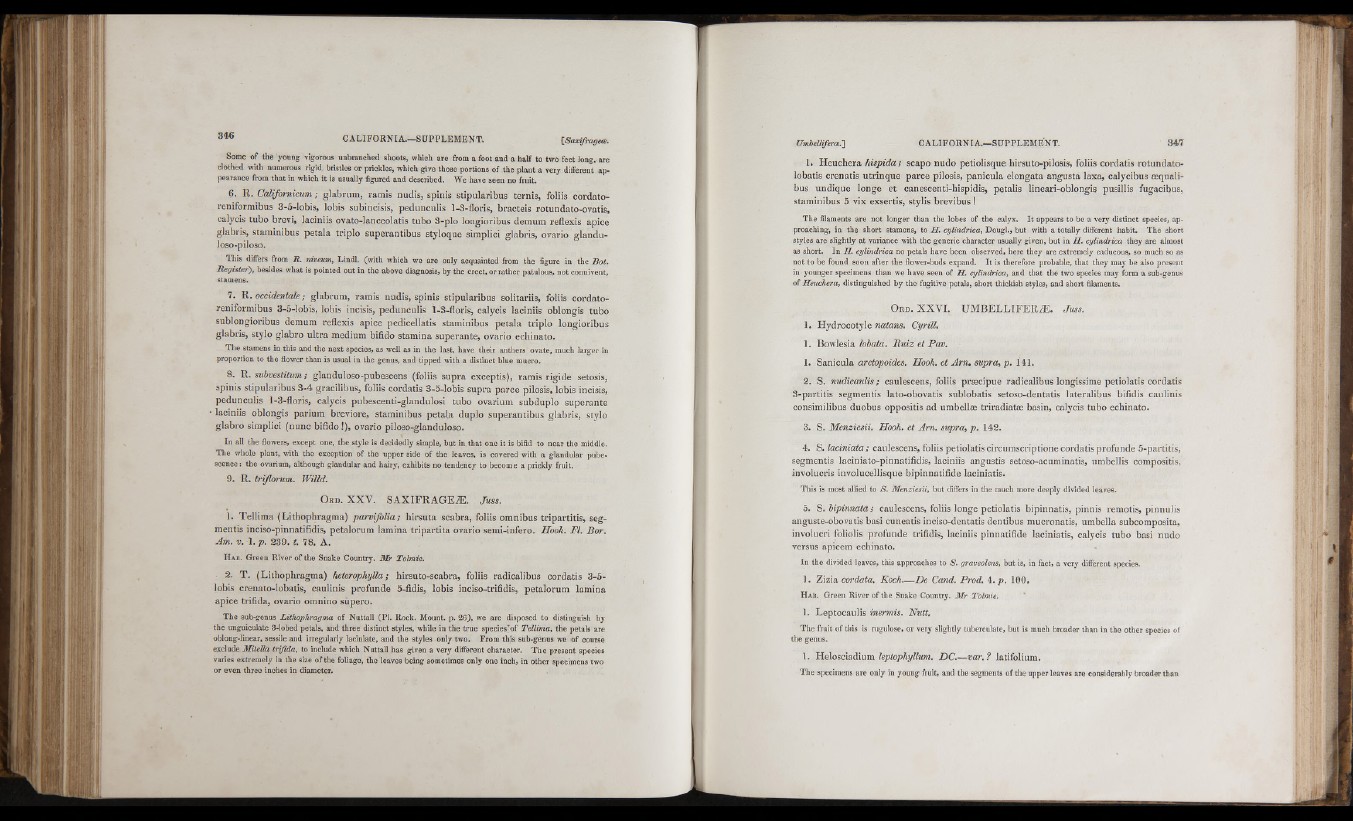
ì l i
r ; , !
I
. 1 -
¡I
II. ,
: I i j i
Some of the young vigorous unbranched shoots, which are from a foot and a half to two feet long, are
clothed with numerous rigid, bristles or prickles, which give those portions of the plant a very different appearance
from that in which it is usually figured and described. We have seen no fruit.
6. R. Californicum ; g labrum, ramis nudis, spinis stipularibus ternis, foliis cordato-
reniformibus 3-5-lobis, lobis subincisis, pedunculis 1-3-floris, bracteis rotundato-ovatis,
calycis tubo brevi, laciniis ovato-lanceolatis tubo 3 -plo longioribus demum reflexis apice
glabris, staminibus peta la trip lo superantibus styloque simplici glabris, ovario g landu-
loso-piloso.
This differs from R . niveum, Lindi, (with which we are only acquainted from the figure in the £ o (.
Register), besides what is pointed out in the above diagnosis, by the erect, or rather patulous, not connivent,
stamens.
7. R . occidentale ; glabrum, ramis nudis, spinis stipularibus solitariis, foliis cordato-
reniformibus 3-3-lobis, lobis incisis, pedunculis 1-3-floris, calycis laciniis oblongis tubo
sublongioribus demum reflexis apice pedicellatis staminibus petala trip lo longioribus
glabris, stylo glabro u ltra medium bifido stamina superante, ovario echinato.
The stamens in this and the nest species, as well as in the last, have their anthers ovate, much larger in
proportion to the flower than is usual in the genus, and tipped with a distinct blue mucro.
8. R . subvestitum ; glanduloso-pubescens (foliis su p ra exceptis), ramis rigide setosis,
spinis stipularibus 3-4 gracilibus, foliis cordatis 3-5-lobis su p ra p a rc e pilosis, Iobis incisis,
pedunculis 1-3-floris, calycis pubescenti-glandulosi tubo ovarium subduplo superante
• laciniis oblongis parium breviore, staminibus pe ta la d uplo su perantibus glabris, stylo
glab ro simplici (nunc bifido!), ovario piloso-glanduloso.
In all the flowers, except one, the style is decidedly simple, but in, that one it is bifid to near the middle.
The whole plant, with the exception of the upper side of the leaves, is covered with a glandular pubescence
: tbe ovarium, although glandular and hairy, exhibits no tendency to become a prickly fruit.
9. R. triflorum. Willd.
O r d . X X V . S A X IF R A G EÆ . Juss.
1. T ellima (Lith o p h ragma) p a rv ifo lia ; hirsu ta scabra, foliis omnibus trip a rtitis , segmentis
inciso-pinnatifidis, petalorum lamina trip a rtita ovario semi-infero. Hook. Fl. Bor.
Am. V. l . p . 239. i. 78. A.
H a b . Green River of tho Snake Country. M r Tolmie.
2. T . (Lith o p h ragm a) heterophylla; hirsuto-scabra, foliis radicalibus cordatis 3-5-
lobis crenato-lobatis, caulinis profunde 5-fidis, lobis inciso-trifidis, p etalo rum lamina
apice trifida, ovario omnino supero.
The sub-genus Lithophragma of Nuttall (PI. Rock. Mount, p. 26), we are disposed to distinguisli by
the unguiculate 8-lobed petals, and three distmct styles, while in the true species’of Tellima, the petals are
oblong-linear, sessile and irregularly laciniate, and the styles only two. From this sub-genus we of course
exclude Milella trifida, to include which Nuttall has given a very different character. The present species
varies extremely in the size of the foliage, the leaves being sometimes only one inch, in other specimens two
or even three inches in diameter.
1. H eu ch era h isp id a ; scapo nudo petiolisque hirsuto-pilosis, foliis cordatis rotundato-
lobatis crenatis u trin q u e p arce pilosis, panicula elongata angusta laxa, calycibus æqualibus
undique longe e t canescenti-hispidis, petalis lineari-oblongis pusillis fugacibus,
staminibus 5 vix exsertis, stylis brevibus !
The filaments are not longer than the lobes of the calyx. I t appears to be a very distinct species, approaching,
in the short stamens, to H. cylindrica, Dougl, but with a totally different habit. The short
styles are slightly at variance with the generic character usually given, but in H . cylindrica they are almost
as short. In H. cylindrica no petals have been observed, here they are extremely caducous, so much so as
not to be found soon after the flower-buds expand. It is therefore probable, that they may be also present
in younger specimens than we have seen of H. cylindrica, and that the two species may form a sub-genus
of Heuchera, distinguished by the fugitive petals, short thiekish styles, and short filaments.
O r d . X X V I . U M B E L L IF E R Æ . Juss.
I. Hydrocotyle natans. Cyrill.
1. B ow le s ia /oôaia. R u i z et Pav.
1. Sanícula arctopoides. Hook, et Arn . supra, p. 141.
2. S. nudicaulis; caulescens, folüs præcipue radicalibus longissime petiolatis cordatis
3 -p artitis segmentis lato-obovatis sublobatis setoso-dentatis lateralibus bifidis caulinis
consimilibus duobus oppositis ad umbellæ trirad ia tæ basin, calycis tubo echinato.
3. S. Menziesii. Hook, et Arn. supra, p . 142.
4. S. laciniata; caulescens, foliis petiolatis circumscriptione cordatis profunde 5-partitis,
segmentis laciniato-pinnatifidis, laciniis angustis setoso-acuminatis, umbellis compositis,
involucris involucellisque bipinnatifide laciniatis.
This is most allied to S . Menziesii, but differs in the much more deeply divided leaves.
5. S. bipinnata; caulescens, foliis longe petiolatis bipinnatis, pinnis remotis, pinnulis
anguste-obovatis basi cuneatis inciso-dentatis dentibus mucronatis, umbella subcomposita,
involucri foliolis profunde trifidis, laciniis pinnatifide laciniatis, calycis tubo basi nudo
versus apicem echinato.
In the divided leaves, this approaches to S . graveolens, but is, in fact, a very different species.
1. Zizia cordata. Koch De Cand. Prod. 4. p . 100.
H a b . Green River of the Snake Country. Mr Tolmie.
]. Leptocaulis ¿»emts. Nutt.
The fruit of this is rugulose, or very slightly tuberculate, but is much broader than in the other species of
the genus.
1. RúosciaCámn leptophyllum. D C .—var.? latifolium.
The specimens are only in young fruit, and the segments of tbe upper leaves are considerably broader than